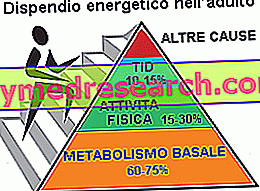Energy from macronutrients
The energy released by the in vivo oxidation of macronutrients corresponds approximately to:
- 4 Kcal for every gram of protein
- 4 Kcal per carbohydrate gram
- 9 Kcal for every gram of lipids
While carbohydrates and lipids are completely demolished during oxidative catabolism, not all the energy enclosed in the amino acid molecules is released. In fact the nitrogenous part of the amino acid, called amino group, is previously removed and destined to a particular metabolic pathway (formation of ammonia, urea cycle and subsequent urinary elimination of nitrogenous waste). The remaining part of the amino acid, called the carbon skeleton, is used to produce energy.
The energy from the macronutrient catabolism is committed by the body to support the energy demands deriving from:
- basal metabolism
- Diet-induced thermogenesis (TID)
- physical activity (not necessarily sport)
- thermoregulation

Basal metabolic rate (BMR, basal metabolic rate) is defined as the energy spent by the body to perform normal vegetative functions and stay alive. These functions, vital because they cannot stop, include:
- breathing
- heart rate and blood circulation
- renal filtration
- hepatic activity
- brain activity
- glandular secretions
- maintenance and renewal of body tissues
Basal metabolism
More than half of the energy spent daily (around 60-70%) is responsible for supporting the vital functions linked to basal metabolism.
BMR is related to the subject's body surface, which is why it is usually expressed in Kcal per hour, per square meter of body surface. In this regard, there are specific tables (nomograms) that relate the weight and height of the subject, restoring the corresponding extension of the body surface.
At the same weight, a taller person has a greater body surface and, consequently, a higher basal metabolism than that of a lower stature subject.
Basal metabolism is influenced by many factors:
| sex | by virtue of the greater muscular masses, the basal metabolism is higher in men than in women. Muscle tissue is in fact very metabolically active and, both during physical activity and during rest, allows us to burn a lot of calories |
| age | basal metabolism reaches its maximum values in the first years of life; just think that a child triples its weight within twelve months of birth; after 10 years, even if very gradually, the basal metabolism tends to decrease, decreasing more and more with the passing of the years |
| nutrition | a malnourished person has a basal metabolism lower than the norm; this phenomenon is responsible for the failure of many weight-loss diets which, due to excessive caloric deprivation, depress the metabolism of those who follow them |
| fitness | physically active people have a higher basal metabolic rate, since energy consumption remains high even after several hours from the end of the physical exercise |
| climate | people living in warmer countries generally have a slower metabolism, presumably due to lower thyroid activity |
| body temperature | when the body temperature increases all the chemical reactions of the organism suffer an acceleration; in particular, for each degree of temperature higher than the norm the metabolism undergoes a surge of 13% |
| hormones | thyroid hormones, testosterone, growth hormone and catecholamines have the ability to accelerate basal metabolism |
| pregnancy | especially during the last quarter of gestation, there is a greater energy expenditure to support the growth of the fetus; this also applies to nurses, who need more energy to produce milk |
| sleep | during peaceful sleep the metabolism is lowered essentially for two reasons: in similar conditions the sympathetic activity is lessened and the muscle tone decreases (even when at rest, as long as you are awake, a small part of muscle fibers is contracted; this phenomenon is named of muscle tone). During sleep, on the other hand, all the fibers are completely relaxed and the muscle tone is lost. For this reason basal metabolism should never be measured during sleep |
| some drugs and supplements | amphetamines, caffeine, ephedrine, guarana, thyroid hormones and the like, appreciably raise basal metabolism |
The measurement of basal metabolism is useful in the sports field, but also in the medical field, for example in the evaluation of some metabolic diseases, such as thyroid dysfunction, obesity and diabetes.
CONTINUE: diet-induced thermogenesis "



